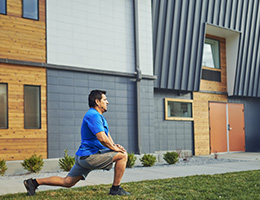
All it takes is one wrong move—perhaps a sudden twist or a fall. Next thing you know, ouch! You're dealing with a painful sprain or strain. This could happen while you're shooting hoops, hiking a trail or taking part in a variety of other physical activities.
In fact, sprains and strains are two of the most common types of athletic injuries, according to the American Academy of Orthopaedic Surgeons (AAOS).
Luckily, there are steps you can take to avoid them.
Sprains and strains
When you take part in sports and physical fitness activities, an awkward motion can result in damage to your ligaments, tendons or muscles. Most of the time, these soft-tissue injuries are diagnosed as sprains or strains.
A sprain takes place when you stretch or tear a ligament—the tissue that connects one bone to another. Areas vulnerable to injury are the ankles, knees and wrists.
You can sprain an ankle by turning your foot too far inward. Knee sprains often take place when you suddenly twist your knee, while wrist sprains are usually the result of an outstretched hand.
A strain occurs when you injure a tendon—which connects muscle to bone—or a muscle. Strains usually take place in your foot or leg. But you can also strain your back, shoulder or elbow.
Strains can be a simple stretch or overextension of a muscle or tendon, such as a hamstring. Or they can be more serious, such as a partial or complete tear of the tendon and muscle.
Most mild sprains and strains can be treated with RICE (rest, ice, compression and elevation).
Stay in shape
One of the best things you can do is keep yourself in good physical condition. Most adults should get about 150 minutes of moderate aerobic physical activity each week. You can break that exercise up into short sessions, if you're pressed for time.
One example of moderate aerobic exercise is brisk walking. Or you can do more vigorous exercise (like jogging) 75 minutes a week, or a combination. And try to do exercises that strengthen your muscles two days a week.
Injury prevention
To prevent strains and sprains, the AAOS and the National Institute of Arthritis and Musculoskeletal and Skin Diseases say you should also:
- Warm up and stretch before any type of physical activity. For example, you might run in place for a few minutes.
- Run on even surfaces.
- Stretch every day—even when you're not planning to work out. Strive for a balanced exercise program that includes flexibility activities like stretching.
- Make sure you have the proper equipment and shoes for your activity. Be sure to replace shoes when they wear down.
- Follow a well-balanced diet to help keep your muscles strong.
- Don't exercise if you're tired or in pain.
- Don't overdo it. If you aren't used to an activity, start slowly and work your way up.
- If you do get injured, talk to your doctor about when it's safe to return to your activity.
Taking precautions and proper care of your body will help you participate in the activities you enjoy without getting hurt.
Reviewed 11/21/2024